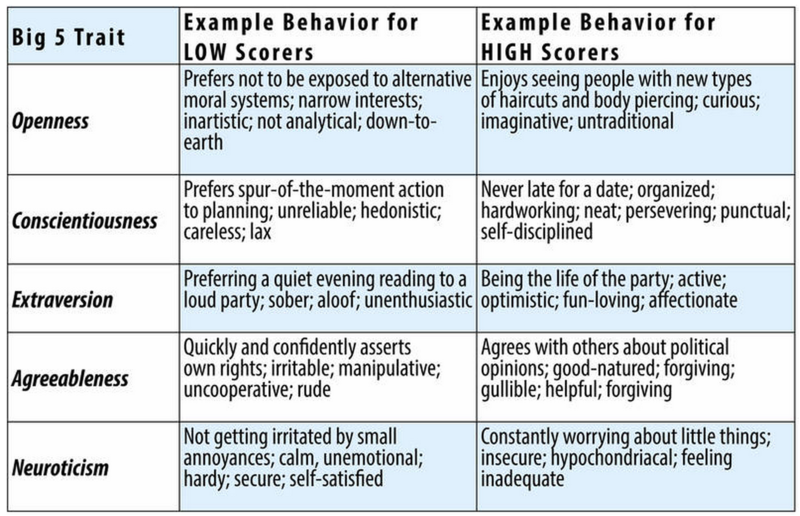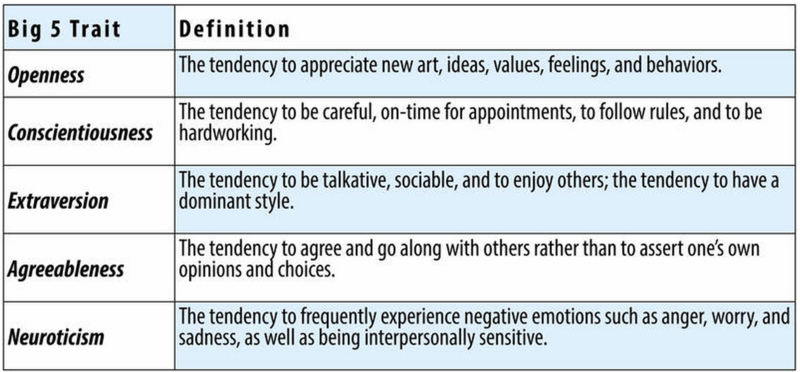What Are the Different Trait Dimension Used to Describe Personality
Personality traits reflect basic dimensions on which people differ Matthews Deary Whiteman 2003. And was of the view that these dimensions were genetically and biologically based.

Circular Diagram Big Five Personality Dimensions Big Five Personality Traits Extraversion Positive Character Traits
This trait includes characteristics such as excitability sociability talkativeness assertiveness and high amounts of emotional expressiveness.

. A Three traits- Neuroticism Agreeableness and Openness - are positively correlated. Those five traits are. What is one strength of the trait approach.
Each of the five personality factors is composed of a range between. Eysenck 1947 found that their behavior could be represented by two dimensions. Dimension of personality used to categorize people according to the degree to which they manifest a particular characteristic.
It seeks to describe the key dimensions of personality but does not attempt to determine how various traits develop how they influence behavior or why they are important. This personality dimension includes attributes such as trust altruism kindness affection and other pro. Many modern and traditional studies in psychology point to 5 basic dimensions of personality.
Neuroticism Stability N. Describe how free association is used as a tool in psychoanalysis. These dimensions are as.
This technique reduces behavior to a number of factors which can be grouped together under separate headings called dimensions. Using different measures keep identifying the same 5. Openness suggests characteristics that include having broad range of interests and willing to try out even most unusual ideas.
This model identifies five fundamental personality trait dimensions characteristics that are believed to be stable across time cross-culturally shared and an explanation for most human behaviour. Eysenck called these second-order personality traits. The Big Five personality traits consist of.
Openness to experience includes aspects such as intellectual curiosity and creative imagination Conscientiousness organization productiveness responsibility Agreeableness compassion. An individuals characteristic pattern of thinking feeling and acting. Tap card to see definition.
This dimension measures traits such as creativity intellectual curiosity imagination adventurousness appreciation of the arts abstract thinking variety of experience and sensitivity to emotions and beauty. WHAT IS A TRAIT. The descriptive terms such as out-going short tempered generous are all traits.
This is true with respect to the big five model which was based initially on the fact that when asked to describe others most people use these dimensions. These traits are called domains because they describe the. Conscientiousness agreeableness neuroticism openness to experience and extraversion are the five major personality dimensions.
Its a method of exploring the unconscious in which the person relaxes and says. Click again to see term. An average person lies somewhere between the two polar ends of each dimension.
2 TRAITS DESCRIBE INDIVIDUAL DIFFERENCES. The five broad personality traits described by the theory are extraversion also often spelled extroversion agreeableness openness conscientiousness and neuroticism. Introversion Extroversion E.
B The traits are all negatively correlated. Eysencks trait theory of personality. Openness to experience In simple terms it can be referred to as the persons willingness to try out new things new experiences.
A high score on one of the traits tends to predict a low score on another. Eysenck divided his theory into two broad dimensioneach dimension containing specific traits. Trait Theory of Personality.
Trait approach is one of the most vital areas of study in psychology that helps identify a persons personality. Each dimension describes a different trait people tend to share. While there have been many different theories of personality many psychologists today believe that personality is made of if five broad dimensions a notion often referred to as the big five theory of personality or the five-factor model.
According to trait psychologists there are a limited number of these dimensions dimensions like Extraversion Conscientiousness or Agreeableness and each individual falls somewhere on each dimension meaning that they could be low medium or high on any. Here are the five different dimensions that make up personality according to the Big Five model. Click card to see definition.
The big five personality traits the theory describes are. Similarly what these five traits suggest is that most people fall under one of these categories. The big five sometimes referred to using the acronym OCEAN are 5 trait dimensions used to describe the core of human personality.
Traits in psychology refer to the ways in which we generally describe a person. Tap again to see term. C The traits are relatively independent.
4 TRAITS CAN BE DISTINGUISHED FROM STATES. 1 Openness to Experience. What is the best way to describe the relationship between the personality traits in the Five-Factor Model.
3 TRAITS ARE BIPOLAR. Evidence of this theory has grown over the years with the principle theory emerging in 1949.

16 1 Personality Traits Introduction To Psychology

16 1 Personality Traits Introduction To Psychology

The Big 5 Personality Traits Aka The 5 Factor Model Ffm Ocean Or Canoe Https Big Five Personality Traits Trait Theory Introduction To Psychology

No comments for "What Are the Different Trait Dimension Used to Describe Personality"
Post a Comment